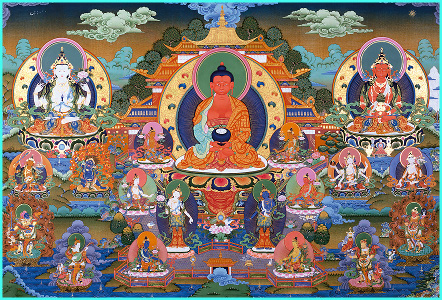Smaller Sukhavativyuha Sutra: Difference between revisions
No edit summary |
No edit summary |
||
| (4 intermediate revisions by 3 users not shown) | |||
| Line 1: | Line 1: | ||
[[File:Sukhavati.jpg|frame|[[Sukhavati]]]] | [[File:Sukhavati.jpg|frame|[[Sukhavati]]]] | ||
The '''Smaller Sukhavativyuha Sutra''' (Skt. ''Sukhāvatīvyūhasūtra'' | The '''Smaller Sukhavativyuha Sutra''' (Skt. ''Sukhāvatīvyūhasūtra''; Tib. བདེ་བ་ཅན་གྱི་བཀོད་པའི་མདོ་ , ''dewachen gyi köpé do'', [[Wyl.]] ''bde ba can gyi bkod pa'i mdo''), which takes place in the [[Jetavana|Jeta Grove]], contains a detailed description by [[Buddha Shakyamuni]] of the [[Sukhavati]] pure realm of Buddha [[Amitabha]]. Buddha Shakyamuni further explains how virtuous people who focus single-mindedly on Buddha Amitabha will obtain a rebirth in Sukhavati in their next life, and he urges all to develop faith in this teaching. In support, he cites the similar way in which the various buddhas of the six directions exhort their followers to develop confidence in this teaching on Sukhavati. The sutra ends with a short dialogue between [[Shariputra]] and Buddha Shakyamuni that highlights the difficulty of enlightened activity in a degenerate age.<ref>Source: 84000</ref> | ||
The Sanskrit term ''vyūha'' (Tib. བཀོད་པ་, ''köpa'', Wyl. bkod pa) means display: | The Sanskrit term ''vyūha'' (Tib. བཀོད་པ་, ''köpa'', Wyl. ''bkod pa'') means display: the sutra is a description of the Sukhavati pure realm and its characteristics. | ||
==Text== | |||
The Sanskrit version of this text is still extant today. According to the Sanskrit scholar Luis Gomez, the text first appeared in its written form during the first century ᴄᴇ, possibly in what was then Northwest India and is now Pakistan.<ref>Id.</ref> | |||
There are several Chinese translations of this sutra, dating from between 240 and 400 ᴄᴇ. | |||
It was translated into Tibetan from Sanskrit by [[Danashila]] and [[Shyang Yeshé Dé]] in the eighth or ninth century. It can be found in the: | |||
*[[General Sutra]] section, [[Toh.]] 115 | |||
===English Translations=== | |||
*{{84000|http://read.84000.co/translation/UT22084-051-003.html|The Display of the Pure Land of Sukhāvatī}} | |||
*[http://www.lapislazulitexts.com/shorter_sukhavativyuha_sutra.html Translation from the Chinese on Lapis Lazuli Texts] | |||
==References== | |||
<small><references/></small> | |||
==Internal Links== | ==Internal Links== | ||
*[[Amitabhavyuha Sutra]] (Longer | *[[Amitabhavyuha Sutra]] ("Longer" ''Sukhavativyuha Sutra'') | ||
[[Category:Texts]] | [[Category: Texts]] | ||
[[Category:Sutras]] | [[Category: Sutras]] | ||
[[Category: | [[Category: General Sutra Section]] | ||
[[Category: Mahayana Sutras]] | |||
Latest revision as of 23:57, 8 February 2021

The Smaller Sukhavativyuha Sutra (Skt. Sukhāvatīvyūhasūtra; Tib. བདེ་བ་ཅན་གྱི་བཀོད་པའི་མདོ་ , dewachen gyi köpé do, Wyl. bde ba can gyi bkod pa'i mdo), which takes place in the Jeta Grove, contains a detailed description by Buddha Shakyamuni of the Sukhavati pure realm of Buddha Amitabha. Buddha Shakyamuni further explains how virtuous people who focus single-mindedly on Buddha Amitabha will obtain a rebirth in Sukhavati in their next life, and he urges all to develop faith in this teaching. In support, he cites the similar way in which the various buddhas of the six directions exhort their followers to develop confidence in this teaching on Sukhavati. The sutra ends with a short dialogue between Shariputra and Buddha Shakyamuni that highlights the difficulty of enlightened activity in a degenerate age.[1]
The Sanskrit term vyūha (Tib. བཀོད་པ་, köpa, Wyl. bkod pa) means display: the sutra is a description of the Sukhavati pure realm and its characteristics.
Text
The Sanskrit version of this text is still extant today. According to the Sanskrit scholar Luis Gomez, the text first appeared in its written form during the first century ᴄᴇ, possibly in what was then Northwest India and is now Pakistan.[2]
There are several Chinese translations of this sutra, dating from between 240 and 400 ᴄᴇ.
It was translated into Tibetan from Sanskrit by Danashila and Shyang Yeshé Dé in the eighth or ninth century. It can be found in the:
- General Sutra section, Toh. 115
English Translations
References
Internal Links
- Amitabhavyuha Sutra ("Longer" Sukhavativyuha Sutra)